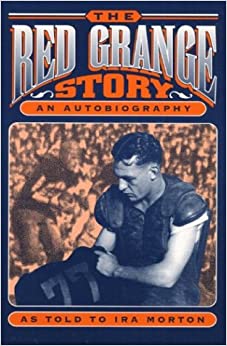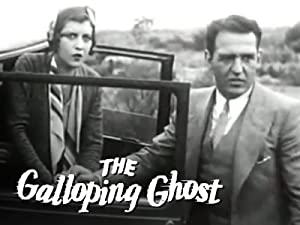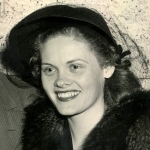Background
Red Grange, alias of Harold Edward Grange, was born on June 13, 1903, in Forksville, Pennsylvania, United States. He was the third child of Lyle Grange, a lumber camp foreman and later the chief of police, and Sadie Grange.

1924
Red Grange starts for the goal line during the game against Michigan.
1925
Red Grange runs with the ball while playing for the University of Illinois. Photo by Getty Images.
1925
Chicago, Illinois, United States
Red Grange at left trying to get through the Chicago Cardinals line in the game between the Chicago Bears and the Cardinals in Chicago when Grange played his first professional game as a member of the Bears.
1935
Chicago, Illinois, United States
Red Grange (fore) of the Chicago Bears evades a tackle by teammate Joe Zeller during a team practice, Chicago, Illinois. Photo by Alan Fisher/World-Telegram Photo/PhotoQuest.
Red Grange
1993 Tiger trl, Wheaton, IL 60189, United States
Red Grange finished Wheaton Warrenville South High School in 1922.
University of Illinois at Urbana-Champaign, Champaign, Illinois, United States
Red Grange studied at the University of Illinois at Urbana-Champaign from 1922 to 1925.
Red Grange poses for a portrait. Photo by MLB.
Red Grange poses with a block of ice over his shoulder upon returning to his hometown of Wheaton, Illinois, about 1926. Photo by Hulton Archive.
New York City, New York, United States
Red Grange holds papers in the NBC studio, the 1940s. Photo by Pictorial Parade.
Red Grange
(From left to right) Ralph Scott, Red Grange, Vern Mullen and Oscar Knop.
1600 Pennsylvania Avenue NW, Washington, D.C., United States
Red Grange (right), as coach of the Chicago Bears, and Senator William Brown McKinley of Illinois visit the White House.
Cambridge, Massachusetts, United States
Red Grange is seen as he looked on during the Harvard Princeton football gridiron clash at the Cambridge stadium, Massachusetts.
Red Grange
Red Grange (right) with botanist Luther Burbank. Photo from the Bettmann collection.
Red Grange looking over a certified check for 300,000 his advance guarantee for signing a motion picture contract.
Red Grange jumping in the air.
Red Grange (left) with Big Bill Edwards. Photo from Bettmann collection.
Red Grange (left) and George Halas, coach and owner of the Chicago Bears, are discussing the strategy to be used in the coming professional championship match with the New York Giants.
Red Grange (right) sitting down with his agent, Charles C. Pyle.
Canton, Ohio, United States
(Front row, from left to right) Dutch Clark, Curly Lambeau, Mel Hein, Johnny "Blood" McNally, Donald Hutson; (back row, from left to right) Samuel Adrian Baugh, Cal Hubbard, Bronko Nagurski, George Stanley Halas, Red Grange, and Ernest Nevers receive their bust as they were inducted to the Professional Football Hall of Fame, Canton, Ohio.
Red Grange of the Chicago Bears wearing #77 throws a pass.
11th Ave. &, W 54th St, New York, NY 10019, United States
Red Grange instructs a group of juvenile gridiron football players how to buck the line during a lull in a practice session of the Chicago Bears at DeWitt Clinton Park, New York City.
Red Grange and Cosmopolitan star Marion Davies after the game between the Chicago Bears and the Los Angeles Bears. Photo by George Rinhart/Corbis.
Red Grange in the middle 1920s. Photo by Historica Graphica Collection/Heritage Images.
Cicero, Illinois, United States
Red Grange, as the country's orator, addresses 25,000 employees at the Hawthorne Works of the Western Electric Company. Photo by George Rinhart/Corbis.
Los Angeles, California, United States
(From left to right) Lucille Pinson, Red Grange, and Mary McAllister in Los Angeles
Red Grange gives a lesson in pigskin technique to miss Carol Decker of Cleveland, a quarterback on a junior girls' gridiron team.
Red Grange and Earl Britton
Chicago Bears' coach George Halas holds up the jersey numbers of Bill Hewitt (56) and of Bronko Nagurski while Grange wears his old 77.
Red Grange. Photo by George Rinhart/Corbis.
Red Grange as he appeared on his arrival in Philadelphia with the Chicago Bears, the professional football team which he joined after playing his last collegiate game.
Red Grange signing the contract, while Mrs. Lee Kuegel, Mrs. Shallenberger and Mrs. Frank Yombrino witnessed the signing.
Red Grange with teammates. Photo by Bettmann Archive.
Red Grange in action. Photo by Bettmann Archive.
New York City, New York, United States
Suzanne Lenglen greeted by Red Grange (left) and C. C. Pyle, her manager, as she arrived in New York City to begin her professional tennis tour of the United States. Photo by George Rinhart/Corbis.
Red Grange, shown in his summer role. Photo by George Rinhart/Corbis.
Red Grange (center) with his teammates from the Chicago Bears, Dutch Sternaman (left) and George Halas.
Chicago Bears football players, (from left to right) Jas. McMillen, Moon Mullin, Red Grange, George Halas, Larry Walquist, Dutch Sternaman, and Joe Sternaman.
Red Grange (left) and coach Joe Kuharich watch the University of Illinois All-American halfback Johnny Karrar (seated, left) taking the pen from Chicago Cardinals' managing director, Walter Wolfner, as he prepares to sign a one-year contract with the club.
Red Grange folds his sweater with his identifying "77" on it.
Red Grange. Photo by Bettmann Archive.
Red Grange reading
United States
Red Grange with Mrs. Harold Lloyd, former Mildred Davis, at Lloyd studios where Red witnessed being filmed for Lloyd's comedy "For Heaven Sake."
Red Grange at a dinner given to the players by the New York Sun at the Hotel Vanderbilt.
Red Grange as he looked after putting on his makeup in the movie studio where he was making a picture.
Red Grange and his famous lame arm with Dr. Leslie Clough, conducting an examination of his injured arm.
John Bright (right), star Drake University football player, accepts a plaque naming him Iowa's outstanding athlete of 1951, from Red Grange.
Red Grange is shown with Jim Thorpe, Columbia football coach, listening in on the phone while Grange answers it.
Red Grange, with his wife, former stewardess Margaret Hazelberg, in their home
Red Grange as he appeared during one of his rehearsals for the movie when he kissed Eva Gregory, the leading lady, and his director Sam Wood watching.
Red Grange was honored by the fans of the University of Illinois at half-time ceremonies marking the 50th anniversary of Memorial stadium.
200 Inverness Ave, Temple Terrace, FL 33617, United States
Red Grange taught by Johnny Farrell, the county's leading medalist, while at the Temple Terrace Golf & Country Club, in Tampa, Florida. Photo by George Rinhart/Corbis.
Red Grange, shown as trying out for the University of Illinois Baseball team. Photo by George Rinhart/Corbis.
Los Angeles, California, United States
Red Grange, seen at the microphone in the role of a radio announcer for Radio KHJ in Los Angeles. Photo by George Rinhart/Corbis.
A 12-ft statue of Red Grange erected at the University of Illinois in his honor at the beginning of the 2009 football season.
The Chicago Tribune Silver Football award that Grange received in 1924 as the Big Ten's Conference's most valuable player.





































(Grange's autobiography as told to Ira Morton, illustrated...)
Grange's autobiography as told to Ira Morton, illustrated with more than a dozen photographs.
https://www.amazon.com/Red-Grange-Story-Autobiography-Morton/dp/0252063295/ref=sr_1_2?dchild=1&keywords=Red+Grange&qid=1605087694&s=books&sr=1-2
1953

(Football star Red Grange is a target for the gamblers run...)
Football star Red Grange is a target for the gamblers running a ring out of the Mogul Taxi company, intent on fixing college football games.
https://www.amazon.com/Chapter-9-Sign-Sky/dp/B08L1FZD5N/ref=sr_1_1?dchild=1&keywords=Red+Grange&qid=1605089046&s=instant-video&sr=1-1
1931
broadcaster athlete American football player
Red Grange, alias of Harold Edward Grange, was born on June 13, 1903, in Forksville, Pennsylvania, United States. He was the third child of Lyle Grange, a lumber camp foreman and later the chief of police, and Sadie Grange.
The Granges lived with relatives for a while until they could have a home of their own. Although diagnosed with a heart murmur, Red Grange developed a passion for sports at an early age. Playing football and basketball with peers around town was his favorite pastime.
Grange proved himself a natural athlete while studying at Wheaton Warrenville South High School as he received 16 varsity letters, in football, baseball, basketball and track. In total, he scored seventy-five touchdowns and 532 points as a gridiron football player and earned the champion's title in sprint four times during his school years. The record of forty-five points that Grange scored in his final high school game against Downers Grove in the 1921 DuPage County championship remained unbeaten for long enough. To help his father support the family, Grange got a part-time job in an icehouse where he had to deliver blocks of ice door-to-door for $37.50 a week. He was dubbed The Wheaton Iceman after the photos showing him at work were published.
Red Grange entered the University of Illinois in 1922. From the very beginning of his studies, he opted for baseball, basketball and track instead of football. He rejected the call for freshmen football candidates because he believed that other players were simply built bigger than he was. The Zeta Psi fraternity brothers eventually encouraged him to try his hand at the university's team. The coach who saw him in action placed him on the first team. Grange's athletic achievements within a year came to be so remarkable that he was promoted a halfback.
Grange gained national attention for his performance and went on to lead the Western Conference (now the Big Ten) in scoring and was selected an All-American halfback. He defended the title each season during 1923-25 when he played for the varsity squad. He shone in 1924 after scoring touchdowns of 95, 67, 56, and 44 yards in the first quarter of play against a Michigan team. The second half was less impressive as he had a fifth touchdown and threw a touchdown pass in a 39-14 Illinois victory.
Grange continued this dominance over football through his entire stint at college. He ended his collegiate career with thirty-one touchdowns to his credit, sixteen of which from at least twenty yards and nine from more than fifty. He ran 388 times in all, for 2,071 yards, caught fourteen passes for 253 yards and completed forty of eighty-two passes for 575 yards. The football star was featured on the cover of Time magazine on October 5, 1925.
The start of Red Grange's career can be counted from 1925 when he turned professional and signed with the Chicago Bears of the National Football League. The decision to leave the university and turn pro shocked many supporters because at the time professional football was a generally unpleasant sandlot game that barely drew any followers to watch the matches. The Bears was managed by George Halas at the time who agreed to pay Grange the sum of $100,000 a year and a share of the gate revenue. The deal was done with high participation of Charles C. Pyle, a Champaign, Illinois theater owner and promoter, who became Grange's agent.
Grange's debut game with the Bears against Chicago Cardinals held on Thanksgiving Day in 1925 at Cubs Park (present-day Wrigley Field) attracted a record 36,000 spectators. Though the match ended in a 0-0, Grange continued to set attendance records as people came to see his excellent mastery of running the ball, his great passing, kicking, and defense. Pyle, as Grange's agent, scheduled the Bears' numerous exhibition games and provided his client with a number of endorsement deals, including two movie roles, in One Minute to Play and The Racing Romeo. Later, in 1931, Grange starred in his own TV-series, The Galloping Ghost.
After playing a year for the Chicago Bears, Red Grange left the team to form the American Football League with Pyle. The league existed only a year which Grange spent in the squad of the New York Yankees. In 1927, the team became part of the NFL. A serious knee injury that Grange had received early that same year made him miss the next entire season. In 1929, he rejoined the Chicago Bears.
Grange remained with the team for another five seasons. He couldn't be anymore the explosive runner he had been because of the injury but he served well as a defensive back and a leading rusher. In the first-ever NFL championship game, Grange made a touchdown-saving tackle late in the fourth quarter, leading the Bears to a 23-21 victory over the New York Giants. Later, the football star was reduced to a utility player.
Red Grange retired from pro football in 1934. He remained with the Chicago Bears as the backfield coach from 1935 to 1937, and also launched a successful career in sports broadcasting. He served both on radio and TV as commentator and television sports announcer till 1969 and earned money from vaudeville and movie appearances as well. In 1942, he established his own insurance practice, which he maintained until he retired to Lake Wales, Florida.

Red Grange is widely recognized for his contributions to both college and professional football. His skills on the field attracted millions of fans to the game, and that unique ability of bringing previously unparalleled popularity and respect to American football is still highly praised. He carried the ball 4,013 times as a high school, college, and professional football player, earning 33,820 yards or over nineteen miles. He achieved a total of 2,365 points in 247 games.
Grange became one of the pioneer professional athletes to sign endorsement deals and to star in motion pictures, paving the way for the cult of personality that is habitual for sports stars of today. Dubbed "The Galloping Ghost," he was also one of the first team sportsmen to have an agent.
In 1924, Grange was the first to receive the Chicago Tribune Silver Football award as the Big Ten's Conference's most valuable player. He was named a charter member to the College Football Hall of Fame in 1951 and to the Professional Football Hall of Fame twelve years later.
He was placed 80 in the 1999 Sporting News list of 100 Greatest Football Players, and headed the ESPN's Top 25 Players in College Football History list in 2008. There is a 12-ft statue at the University of Illinois erected in his honor at the beginning of the 2009 football season.
(Grange's autobiography as told to Ira Morton, illustrated...)
1953(Football star Red Grange is a target for the gamblers run...)
1931Red Grange was a man of conservative political views.
Quotations:
"If you have the football and 11 guys are after you, if you're smart, you'll run."
"I never got the idea that I was a tremendous big shot. I could carry a football well, but there are a lot of doctors and teachers and engineers who could do their thing better than I."
Red Grange was a member of the Zeta Psi fraternity while studying at the University of Illinois.
Red Grange was a very modest person.
Physical Characteristics:
Red Grange didn't actually match the football physical standards since he weighed around 180 pounds during his career and stood about 1.80 meters tall. He was dubbed "Red" for his auburn hair.
He was seriously injured in a 1922 high school football game with Scott High School in Toledo, Ohio. Knocked unconscious during the match, he remained so for the next two days and had troubles with speaking for some time after regaining consciousness.
Quotes from others about the person
Damon Runyon, sportswriter: "This man Red Grange of Illinois is three or four men rolled into one for football purposes. He is Jack Dempsey, Babe Ruth, Al Jolson, Paavo Nurmi and Man o'War. Put together, they spell Grange."
Jerry Liska, Associated Press reporter: "A picture of grace, balance and speed, the epitome of gridiron greatness, a Golden Twenties athletic peer of Babe Ruth's, Jack Dempsey's, Bobby Jones's and Bill Tildon's. Grange, whose magic name turned pro football from an ugly duckling to a present-day gilded and plush bird of paradise, will be remembered as long as football is played in America."
Robert Zuppke, coach: "They can argue all they like about the greatest football player who ever lived. But I was satisfied I had him when I had Red Grange."
Grantland Rice, sportswriter:
"A streak of fire, a breath of flame
Eluding all who reach and clutch;
A gray ghost thrown into the game
That rival hands may never touch;
A rubber bounding, blasting soul
Whose destination is the goal – Red Grange of Illinois!"
Red Grange was a real ladies' man and received bags full of fan mail from female admirers. He had relationships with several Hollywood stars, and his romantic life was largely subject to speculation.
Grange met his wife-to-be, a stewardess Margaret Hazelberg, while flying to Omaha. They entered wedlock in 1941 and remained together till the end of Grange's life. The family was childless. However, Grange had a daughter, Rosemary Morrissey, with one of his former sweethearts - Helen Flozack.
Initially a foreman for a lumber company, Lyle Grange launched a moving business in his native Wheaton, Illinois, after bringing his family there in 1908. He then switched professions and eventually became the chief of police.
(died 1908)

(née Hazelberg)
Margaret Grange's nickname was Muggs.
(born 1928)

(born March 26, 1882 – died February 3, 1939)
Charles C. Pyle, often named Cash and Carry Pyle, was an American sports agent, promoter, and theater owner from Champaign-Urbana, Illinois. In addition to Grange, he also represented tennis player Suzanne Lenglen of France.
